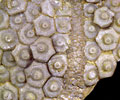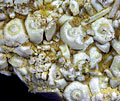The Echinoid Directory
Lepidocidaris Meek & Worthen, 1873, p. 478
| Diagnostic Features |
|
|---|---|
| Distribution | Lower Carboniferous, USA. |
| Name gender | feminine |
| Type | Lepidocidaris squamosa Meek & Worthen, 1873, p. 478, by original designation. |
| Species Included | Only the type species. |
| Classification and/or Status |
|
| Remarks |
|




